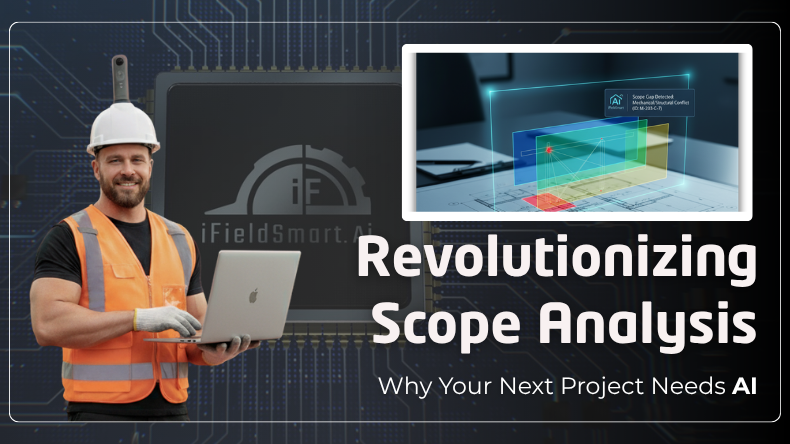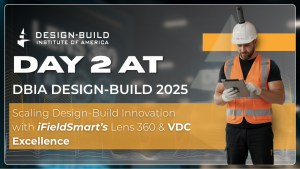Reading Time: 6 minutes
Scope defines what gets built and how it is delivered within planned costs. When the scope is fuzzy, projects face delays and extra costs. Traditional methods of reviewing scope documents often miss hidden gaps. Human error, oversight, and unclear language all add risk. This is where AI changes the game. AI-driven scope analysis tools are designed to spot gaps that humans miss. They read drawings, documents, and data with speed and accuracy. They highlight missing details, unclear terms, and conflicting information before the work begins. That early insight helps teams make better choices and reduce rework.
Why scope analysis matters
Scope gaps show up in many forms. A missed note in a design drawing. A conflicting spec in two documents. A simple measurement written in the wrong place. Each small issue can cause large problems later. Contractors end up guessing. Teams argue over intent. Owners see rising costs. Traditional reviews depend on people flipping through pages or PDFs. Even skilled reviewers get tired. Details slip past. One overlooked note can derail entire timelines. AI turns scope analysis from guesswork into a reliable process. It works faster than any manual review. It spots issues in seconds, not hours.
What AI adds to scope analysis
AI does not just scan documents. It learns patterns from past data. It checks drawings, specs, and contracts against each other. It identifies what is missing or unclear. That saves hours of work and avoids disputes. AI tools from platforms like iFieldSmart AI are built for construction. They look for gaps that affect cost, time, and safety. They flag risks like unclear dimensions, missing notes, or mismatched data. Teams get a clear view of scope health before they begin.
Work Smarter, Not Harder
iFieldSmart empowers your team with AI-driven efficiency to simplify scheduling, boost collaboration, and keep projects on track.
Schedule a MeetingSpeed and accuracy
Manual reviews can take days. AI can finish in minutes. It can check thousands of pages without skipping a line. It highlights conflicts with clear notes. This speed means scope reviews no longer slow down project starts. Accuracy is another benefit. AI does not get tired. It does not overlook fine print. It applies the same focus from page one to page one thousand. That reliability builds trust across project teams.
Early detection saves money
Catching scope gaps early is more than a quality step. It is a financial guardrail. Fixing issues before work begins costs less. Fixing them later often means rework, change orders, or delays. An AI review highlights issues before materials are bought or crews are on site. Teams can adjust plans, update drawings, or clarify notes in time. This proactive step reduces waste and keeps budgets under control.
Collaboration made simple
Scope analysis involves various participants. Designers and contractors need to align. AI provides a shared platform. Everyone sees the same flagged issues. That reduces disputes. It fosters clear communication. Instead of arguing over who missed what, teams can focus on solving issues. AI makes the process transparent. Every gap is highlighted with proof, not opinion.
Real-time insights
With AI, scope analysis is not a one-time event. It can run checks as documents are updated. Each revision is scanned, and changes are flagged. This real-time feedback keeps scope reviews current. Teams no longer wait until the end of design to run checks. They can build confidence in scope accuracy as documents evolve. This steady stream of insights creates a smoother path to execution.
Reducing disputes
Many disputes in construction stem from unclear scope. Owners think that one thing was promised. Contractors read another. The gap leads to claims and legal battles. AI reduces these disputes by catching the gaps before contracts are signed. A clearer scope reduces gray areas. With shared AI reports, all parties start with the same understanding. That cuts down on conflict and builds trust.
AI and risk management
Risk in construction often ties back to scope. If the scope is unclear, risks multiply. Costs rise. Safety can suffer. AI reduces this risk by shining light on hidden issues. It provides measurable data to understand if the scope is weak or strong. Teams can plan with confidence, knowing they are not building on unreliable planning.
Simple adoption
Modern AI tools are easy to adopt. They use file types like PDFs and CAD drawings, and teams do not need training to utilize them. Upload documents, run the analysis, and review flagged gaps. This simplicity means even small teams can benefit. Large firms gain scale, but smaller projects also get better results. AI makes scope reviews accessible for all.
Why expert construction reviews matter?
Scope gap analysis helps teams find missing parts in project plans before work begins. It checks design drawings, models, and documents to catch errors early. When findings are reviewed by experts, they confirm the right and wrong and point out what’s missed. This check keeps teams aligned and avoids costly surprises. Expert reviews bring real-world experience to scope analysis. Reviewers understand how design choices impact construction. They can spot unclear details or mismatched elements that software alone might miss. Their feedback ensures plans are complete, accurate, and ready for execution. This step gives builders and owners more confidence in the project’s direction. When scope analysis and expert review work together, projects run smoother. Fewer clashes appear during construction. Teams avoid rework, delays, and budget strain. Clear scope understanding also builds trust between architects, engineers, and contractors. It’s a simple but strong process that saves time and protects profit.
Future potential
AI in scope analysis is still growing. As tools learn from more data, they will get sharper. Future versions may predict cost risks, track safety concerns, or even suggest design fixes. For now, the value is clear. AI reduces waste, avoids disputes, and improves clarity. That alone is reason enough to adopt it today.
Why your next project needs AI
Every project faces the risk of scope gaps. Ignoring it adds cost and stress. Old reviews cannot keep up with modern project needs. AI-driven scope analysis provides a way ahead. It creates speed and clarity within a critical process. It helps teams save money and reduce risk. The construction industry has long searched for better ways to manage scope. With AI, that solution is now available. It is a tool that addresses the actual issues, not a trend. It implies fewer surprises for owners. For contractors, it means less rework. For designers, it means fewer disputes. Your next project deserves that level of clarity. Scope analysis powered by AI is not optional anymore. It is the smart choice.
Conclusion
Scope defines success. Gaps in scope create failure. Traditional reviews are slow, tiring, and prone to errors. AI transforms scope analysis. It finds hidden issues, speeds up reviews, and provides accurate results. It helps teams align before they build. It saves money and keeps projects on track. Construction thrives on clear plans. AI makes those plans stronger. If your next project matters, it deserves AI-powered scope analysis.








